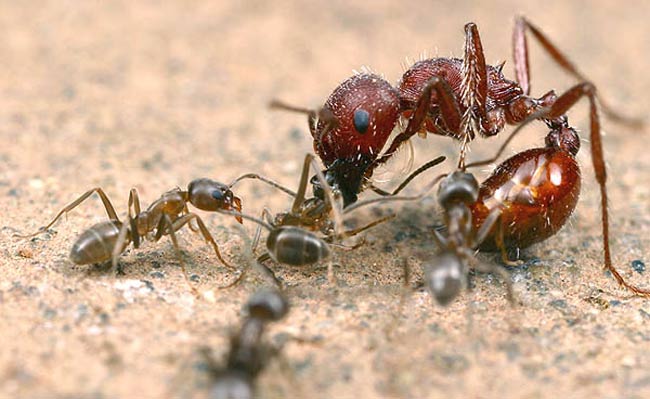Vicious Ants Made to Attack Their Own

They may be tiny, but Argentine ants can kick some ant butt. This invasive species has nearly wiped out native ants in California.
Now scientists have discovered a way to turn one of the ants' strongest weapons into a weakness.
By altering the identifying chemicals coating the ants' bodies, researchers turned typical cooperative behavior into an ant-family feud.
Super colony
Like most ants, the Argentine ant (Linepithema humile) relies on chemical tags to identify friend or foe [photo]. The chemicals are waxy and can't evaporate into the air like other animal communication chemicals called pheromones. The ants must make physical contact to smell them.
Scientists suspect that a single colony of the ants, originally from South America, hitched a ride to the United States in the 1890s aboard multiple cargo ships that docked in Louisiana.
Since most of the Argentine ants now in California descended from a single colony, they are pals and wear matching chemical coats. Unlike in South America, where there are several smaller ant colonies, most of the Argentine ants in California belong to "one gigantic super colony that stretches basically from San Diego all the way to San Francisco, so you could take an ant from San Diego and put it in a nest in San Francisco and they would treat them the same as if they are family," said study team member Robert Sulc, a graduate student at the University of California, Irvine.
Get the world’s most fascinating discoveries delivered straight to your inbox.
That's a problem for native ant species that are fewer in number.
Even though they are just an eighth of an inch long, their sheer numbers have allowed the invasive ants to kick out or kill [photo] other ant colonies in California, study team member Kenneth Shea, an organic chemist at the university, told LiveScience.
To try and outsmart the ants, the research team, led by UC Irvine evolutionary biologist Neil Tsutsui, whipped up batches of chemical compounds with a similar structure to those coating the Argentine ant colonies. When they coated one of the colony ants with the new compound, the other ants began attacking it as an enemy.
"Our preliminary results strongly suggest that by manipulating these chemicals on the exoskeleton, one could disrupt the cooperative behavior of these ants and, in essence, trigger civil unrest within these huge colonies," Shea said.
The work was described today at a meeting of the American Chemical Society in San Francisco.
"I think that this is really important, because they are finally starting to crack the code of how Argentine ants recognize and communicate with each other," said Brian Fisher, curator of entomology at the California Academy of Sciences. Fisher was not involved in the study.
Dizzying experiment
Getting the chemical treatment was dizzying. First, Tsutsui and his team coated the inside of a vial with the chemical. They plopped an ant into the tube and spun it in a machine for 90 seconds to make the chemical stick.
"After all that shaking it's a little bit wobbly but usually it's still alive," Sulc said. "Then, we put it back into the Petri dish with ten of its friends from the same colony and then we observe how aggressive they are toward him."
The other ants immediately attacked, using their large mandibles, or jaws, to bite and tear off its legs, Sulc said.
The invasion of Argentine ants could ripple through the ecosystem, affecting more than just the native ants. For instance, the Coastal Horned lizard relies exclusively on the native ants for food, and as these ants dwindle so could the lizard.
Until now, neither pesticides nor trapping has thwarted the spread of the Argentine ants.
The scientists hope the strategy could be used in the future to finally check the spread of the Argentine ants.
Jeanna Bryner is managing editor of Scientific American. Previously she was editor in chief of Live Science and, prior to that, an editor at Scholastic's Science World magazine. Bryner has an English degree from Salisbury University, a master's degree in biogeochemistry and environmental sciences from the University of Maryland and a graduate science journalism degree from New York University. She has worked as a biologist in Florida, where she monitored wetlands and did field surveys for endangered species, including the gorgeous Florida Scrub Jay. She also received an ocean sciences journalism fellowship from the Woods Hole Oceanographic Institution. She is a firm believer that science is for everyone and that just about everything can be viewed through the lens of science.


